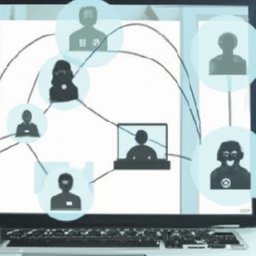How Can I Improve My Company’s Network Security?
In today’s digital world, ensuring the security of your company’s network is of utmost importance. With cyber threats becoming increasingly sophisticated, it is crucial to constantly assess and enhance your network security measures. From implementing robust firewalls to regularly updating security protocols, there are several steps you can take to strengthen the security of your company’s network. By prioritizing network security, you can protect your sensitive information, safeguard your reputation, and maintain the trust of your clients and stakeholders.
Creating a Network Security Plan
A comprehensive network security plan is crucial for protecting your company’s sensitive information and ensuring the smooth operation of your network. By following these steps and implementing the necessary measures, you can significantly improve your company’s network security.
Identify Potential Threats
The first step in creating a network security plan is to identify the potential threats your company may face. These threats can include malware, phishing attacks, data breaches, and insider threats. By understanding the threats that exist, you can tailor your security measures to effectively mitigate them.
Assess Current Security Measures
Before implementing any new security measures, it is essential to assess your current security measures. This includes evaluating your existing firewall, antivirus software, and intrusion detection systems. By identifying any weaknesses in your current setup, you can make informed decisions on how to improve and strengthen your network security.
Define Security Policies
Defining clear security policies is vital for establishing a strong foundation for network security. These policies should outline the rules and guidelines that employees must adhere to regarding network usage, password management, and data access. By clearly communicating these policies to your employees, you can ensure that everyone understands their roles and responsibilities in maintaining network security.
Implement Firewalls and Intrusion Detection Systems
Firewalls and intrusion detection systems are essential components of any network security plan. Firewalls act as a barrier between your company’s internal network and the outside world, filtering incoming and outgoing network traffic. Intrusion detection systems monitor network traffic for suspicious activity and alert you to potential threats. By implementing these systems, you can detect and prevent unauthorized access to your network.
Strengthening User Authentication
User authentication is a critical aspect of network security, as weak authentication measures can leave your network vulnerable to unauthorized access. By implementing the following measures, you can strengthen user authentication and enhance overall network security.
Enforce Strong Password Policies
One of the easiest ways for attackers to gain access to your network is through weak passwords. Enforcing strong password policies, such as requiring a minimum length, combination of alphanumeric and special characters, and regular password changes, can significantly improve your network’s security. Additionally, educating employees about the importance of strong passwords and providing best practices for creating secure passwords can further enhance security.
Implement Multi-Factor Authentication
Multi-factor authentication adds an extra layer of security by requiring users to provide additional credentials beyond just a password. This can include a one-time code sent to a mobile device or the use of biometrics such as fingerprints or facial recognition. By implementing multi-factor authentication, even if an attacker manages to obtain a user’s password, they would still need the additional factor to gain access.
Regularly Update User Credentials
Regularly updating user credentials, such as usernames and passwords, is essential for maintaining network security. This includes removing access for employees who have left the company or changed roles, as well as ensuring that privileged accounts have unique and strong passwords. By regularly updating user credentials, you can minimize the risk of unauthorized access due to compromised or outdated credentials.
Train Employees on Secure Authentication Practices
Educating employees on secure authentication practices is crucial for promoting a culture of strong network security. Training sessions should cover topics such as recognizing phishing emails, avoiding suspicious websites, and using secure Wi-Fi networks. By providing employees with the knowledge and tools to identify and respond to potential security threats, you can significantly reduce the risk of successful attacks.
Securing Network Devices
Network devices, such as routers, switches, and access points, play a vital role in maintaining network security. By implementing the following measures, you can secure your network devices and protect against unauthorized access.
Regularly Update Firmware and Software
Regularly updating the firmware and software of your network devices is crucial for addressing potential security vulnerabilities. Manufacturers often release updates that address known vulnerabilities and provide improved security features. By regularly applying these updates, you can ensure that your network devices are protected against the latest threats.
Change Default Passwords and Disable Unnecessary Services
Many network devices come with default passwords that are well-known and widely available. Changing these default passwords to unique, strong passwords is essential for preventing unauthorized access. Additionally, disabling any unnecessary services or ports on your network devices can reduce the potential attack surface and minimize the risk of exploitation.
Physically Secure Network Devices
Physical security measures should not be overlooked when it comes to network security. Ensure that your network devices are located in securely locked areas, accessible only to authorized personnel. This includes server rooms, network closets, and any other locations where network devices are housed. By physically securing your network devices, you can minimize the risk of tampering or theft.
Monitor Network Device Logs
Regularly monitoring the logs of your network devices can provide valuable insights into potential security incidents. Analyzing network device logs can help detect unauthorized access attempts, unusual network traffic patterns, or any other suspicious activity. By actively monitoring network device logs and responding to any detected anomalies, you can proactively address potential security threats and protect your network.
Implementing Access Control Measures
Implementing access control measures is essential for ensuring that only authorized individuals have access to specific areas or resources within your network. By implementing the following measures, you can control user access and reduce the risk of unauthorized activities.
Segregate Network Segments
Segmenting your network into different segments can help limit the impact of potential security breaches. By separating critical systems from less sensitive systems, you can minimize the risk of lateral movement within your network. Implementing network segmentation can also provide additional control over user access to specific resources and applications.
Implement Role-Based Access Control
Role-based access control (RBAC) involves granting access to resources based on the user’s role within the organization. By assigning specific roles and associated permissions to employees, you can ensure that they have access only to the resources necessary for their job responsibilities. Implementing RBAC can minimize the risk of unauthorized access and limit the potential damage in the event of a security breach.
Leverage VLANs and Network Segmentation
Virtual Local Area Networks (VLANs) can be used to create separate logical networks within a physical network infrastructure. By using VLANs to isolate different groups of devices or users, you can control access and limit the spread of potential security incidents. VLANs can be particularly useful in environments with shared resources or multiple departments within an organization.
Monitor and Audit User Activities
Monitoring and auditing user activities can help detect and prevent unauthorized or suspicious behavior within your network. By implementing tools that track user activities, you can identify any deviations from normal user behavior and take appropriate action. Regularly reviewing audit logs and conducting periodic audits can help identify potential security incidents and ensure compliance with security policies.
Ensuring Secure Remote Access
In today’s interconnected world, providing secure remote access is essential for enabling employees to work from anywhere while maintaining network security. By implementing the following measures, you can ensure that remote access to your network is secure and protected.
Use VPN for Remote Access
Virtual Private Networks (VPNs) provide a secure connection between remote devices and your company’s network. By encrypting the data transmitted between the remote device and the network, VPNs protect against unauthorized access and eavesdropping. Implementing VPNs for remote access ensures that confidential information remains secure even when accessed remotely.
Implement Strict Access Controls
When providing remote access to your network, it is essential to implement strict access controls to prevent unauthorized individuals from gaining access. This can include using strong authentication methods, such as multi-factor authentication, and limiting access to specific resources and applications based on user roles and responsibilities. By implementing strict access controls, you can minimize the risk of unauthorized access and protect your network from potential security threats.
Regularly Patch and Update Remote Access Software
Just like any other software, remote access software can have vulnerabilities that can be exploited by attackers. It is crucial to regularly patch and update your remote access software to address any known vulnerabilities and improve security. By staying up to date with the latest software releases, you can ensure that your remote access infrastructure remains secure.
Monitor Remote Access Logs
Monitoring the logs of remote access sessions can provide valuable insights into potential security incidents. analyzing remote access logs can help detect any unusual login attempts, unauthorized access, or suspicious activities. By actively monitoring remote access logs and responding to any identified security incidents, you can protect your network from potential threats and maintain a secure remote access environment.
Regularly Updating and Patching Systems
Regularly updating and patching your systems is crucial for addressing known vulnerabilities and ensuring that your network remains secure. By implementing the following measures, you can effectively manage updates and patches to enhance your network’s security.
Implement a Patch Management Strategy
Developing a patch management strategy is essential for ensuring that updates and patches are applied in a timely and systematic manner. This involves identifying critical systems and applications, establishing a schedule for applying updates, and testing patches before deployment. By implementing a well-defined patch management strategy, you can minimize the risk of unpatched vulnerabilities and improve your overall network security.
Regularly Update Operating Systems and Software
Operating systems and software applications often release updates that include security patches and bug fixes. It is essential to regularly update these systems to address known vulnerabilities and improve security. Enabling automatic updates and regularly checking for available updates can help ensure that your systems are up to date.
Monitor Vendor Security Advisories
Keeping track of security advisories from your software vendors is crucial for staying informed about potential vulnerabilities and security patches. Subscribing to vendor mailing lists or monitoring their websites can provide timely updates regarding security issues and recommended patches. By staying proactive and applying vendor-recommended patches promptly, you can minimize the risk of exploitation and maintain a secure network environment.
Perform Regular Vulnerability Scans
Regularly conducting vulnerability scans can help identify any weaknesses or vulnerabilities in your network infrastructure. These scans involve using specialized tools to scan your network for potential vulnerabilities and security misconfigurations. By performing regular vulnerability scans, you can uncover any potential security weaknesses and take appropriate action to address them.
Encrypting Data in Transit and at Rest
Encrypting data is essential for protecting sensitive information both during transmission and while stored on servers or storage devices. By implementing the following encryption measures, you can ensure that your data remains secure and inaccessible to unauthorized individuals.
Use Secure Protocols for Communication
When transmitting data over the network, it is essential to use secure protocols that encrypt the data in transit. Secure Socket Layer (SSL) and Transport Layer Security (TLS) protocols provide encryption and secure communication between clients and servers. By using secure protocols, you can prevent unauthorized interception and ensure the integrity and confidentiality of transmitted data.
Implement SSL/TLS Certificates
SSL/TLS certificates play a crucial role in enabling secure communication over the internet. By obtaining and implementing SSL/TLS certificates for your website or other network services, you can authenticate your identity to users and establish secure encrypted connections. This helps protect against man-in-the-middle attacks and ensures that sensitive information remains confidential.
Encrypt Sensitive Data on Servers and Storage
Encrypting sensitive data at rest is essential for protecting it from unauthorized access. By implementing encryption on servers and storage devices, you can ensure that even if the physical media is compromised, the data remains inaccessible. This can include encrypting databases, files, and backups containing sensitive information. By encrypting sensitive data, you can provide an additional layer of protection against potential security breaches.
Utilize Endpoint Encryption
Endpoint encryption involves encrypting data on individual devices such as laptops, desktops, and mobile devices. This ensures that even if a device is lost or stolen, the data stored on it remains inaccessible to unauthorized individuals. By implementing endpoint encryption, you can protect sensitive information and maintain data confidentiality, even in the event of a physical security breach.
Conducting Regular Security Audits
Regularly conducting security audits is crucial for assessing the effectiveness of your network security measures and identifying any vulnerabilities or weaknesses. By implementing the following audit practices, you can proactively identify and address potential security issues.
Perform Penetration Testing
Penetration testing, also known as ethical hacking, involves simulating real-world attacks to identify vulnerabilities in your network infrastructure. By hiring trained professionals to conduct penetration tests, you can identify potential security weaknesses that may not be apparent through traditional scans or assessments. By performing regular penetration tests, you can identify and remediate vulnerabilities before they are exploited by malicious actors.
Engage Third-Party Security Auditors
Engaging third-party security auditors can provide an unbiased assessment of your network security posture. These auditors can review your security controls, policies, and procedures to identify any gaps or weaknesses. By leveraging the expertise of external auditors, you can gain valuable insights and recommendations for improving your network security.
Conduct Internal Security Audits
In addition to engaging external auditors, conducting internal security audits is essential for evaluating your ongoing security practices. These audits involve reviewing security logs, analyzing system configurations, and validating adherence to security policies. By regularly conducting internal security audits, you can identify and address any internal security risks or non-compliance issues.
Review and Update Security Policies
Security policies should be reviewed regularly to ensure they remain effective in addressing potential threats. As new technologies, threats, or regulations emerge, it is crucial to update your security policies accordingly. By reviewing and updating security policies, you can ensure that they are aligned with industry best practices and provide clear guidance to employees on how to maintain network security.
Implementing Network Monitoring and Intrusion Detection Systems
Implementing network monitoring and intrusion detection systems is essential for detecting and responding to potential security incidents in real-time. By employing the following measures, you can effectively monitor your network and identify any anomalies or suspicious activities.
Install Network Monitoring Tools
Network monitoring tools allow you to monitor network traffic, identify potential security incidents, and gain visibility into your network’s overall health. These tools provide insights into the volume and types of traffic flowing through your network, as well as any abnormalities or patterns indicative of malicious activity. By installing network monitoring tools, you can proactively monitor your network and respond to potential threats.
Deploy Intrusion Detection Systems
Intrusion Detection Systems (IDS) play a vital role in network security by monitoring network traffic and detecting any suspicious or unauthorized activities. IDS can detect known attack signatures, anomalous traffic patterns, or unauthorized access attempts, and trigger alerts for immediate action. By deploying IDS, you can significantly enhance your network’s security posture and respond to potential threats in real-time.
Monitor Network Traffic and Identify Anomalies
Regularly monitoring network traffic is essential for identifying any unusual patterns or anomalies that may indicate a security incident. Analyzing network traffic can help detect unauthorized connections, unusual data transfers, or any other activities that deviate from normal network behavior. By actively monitoring network traffic, you can identify and respond to potential security incidents promptly.
Configure Real-Time Alerting
Setting up real-time alerting ensures that you are promptly notified of any potential security incidents within your network. This involves configuring your network monitoring and intrusion detection systems to trigger alerts based on specific criteria, such as detecting known attack signatures, network anomalies, or unauthorized access attempts. By configuring real-time alerting, you can initiate immediate response efforts and minimize the impact of security incidents.
Educating Employees on Security Best Practices
Employees play a vital role in maintaining network security, as their actions can either enhance or undermine the overall security posture of the organization. By providing ongoing security awareness training and promoting a security-conscious culture, you can empower your employees to contribute to network security. Implement the following practices to educate and involve your employees in maintaining a secure network environment.
Provide Regular Security Awareness Training
Regular security awareness training is essential for keeping employees informed about the latest security threats and best practices. Training sessions can cover topics such as recognizing phishing emails, creating and managing strong passwords, and securely using company devices and resources. By providing employees with the knowledge and tools to identify and respond to potential security threats, you can significantly reduce the risk of successful attacks.
Encourage Reporting of Suspicious Activities
Encouraging employees to report any suspicious activities or potential security incidents is vital for maintaining a proactive network security posture. Create channels, such as a dedicated email address or an anonymous reporting system, where employees can report any security concerns or incidents they observe. By fostering a culture of reporting, you can ensure that potential security incidents are identified and addressed promptly.
Promote a Security-Conscious Culture
Promoting a security-conscious culture within your organization is crucial for creating an environment where network security is a shared responsibility. This can include developing and enforcing security policies, recognizing and rewarding employees for security-conscious behavior, and leading by example. By promoting a security-conscious culture, you can ensure that network security becomes ingrained in the daily operations of your organization.
Keep Employees Informed of Latest Threats
Regularly communicating with employees about the latest security threats and incidents is essential for keeping them informed and alert. This can include sharing news articles, alerts, or security awareness updates through email, internal newsletters, or employee communication platforms. By keeping employees informed, you can raise awareness about emerging threats and equip them with the knowledge to protect themselves and the organization.
In conclusion, improving your company’s network security requires a comprehensive approach that addresses potential threats, strengthens user authentication measures, secures network devices, implements access control measures, ensures secure remote access, regularly updates and patches systems, encrypts data in transit and at rest, conducts regular security audits, implements network monitoring and intrusion detection systems, and educates employees on security best practices. By following these guidelines and continually evaluating and updating your network security practices, you can significantly enhance your company’s network security and protect against potential threats.








